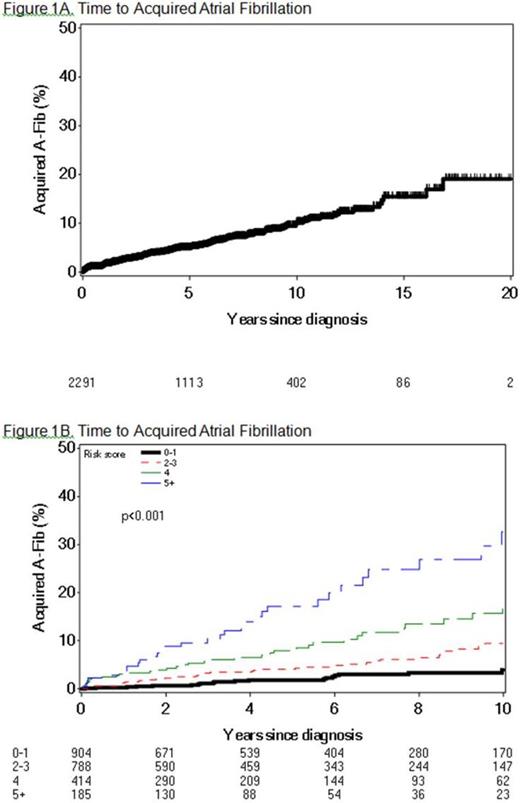Abstract
BACKGROUND:
Consistent with the advanced age at diagnosis (median age ~70 years), most patients with CLL have co-existent health problems. These co-morbidities influence the ability of many CLL patients to tolerate aggressive chemotherapy-based treatment and can also contribute to treatment-related side effects. The recent development of novel signaling inhibitors, particularly the Bruton's tyrosine kinase inhibitor ibrutinib, has been a major treatment advance for patients with CLL. While these agents generally have favorable toxicity profiles relative to standard chemotherapy-based treatments, they are chronic therapies which patients typically stay on for an extended period. Preliminary data suggests ibrutinib may be associated with an increased risk of atrial fibrillation (Afib). In one randomized trial comparing ibrutinib to ofatumumab in patient with relapsed CLL, incident grade 3+ Afib occurred in 3% of ibrutinib treated patients compared to 0% of ofatumumab treated patients (NEJM 371:213). Despite these observations, the baseline frequency of Afib in patients with CLL is not well described - particularly incident atrial fibrillation acquired during the course of the disease.
METHODS: We used the Mayo Clinic CLL database to evaluate the prevalence of Afib at the time of CLL diagnosis as well as the incidence of Afib during follow-up. All patients with a new diagnosis of CLL after January 1995 who were seen at Mayo within 12 months of diagnosis were included in the analysis. Afib was identified by chart review and by billing search using ICD9 codes. Data on co-morbid conditions associated with risk of Afib was also abstracted (e.g. hypertension, coronary artery disease [CAD], valvular heart disease, cardiomyopathy, diabetes mellitus, pulmonary disease).
RESULTS: A total of 2444 patients with newly diagnosed and previously untreated CLL were seen at Mayo Clinic within 12 months of diagnosis between 1/1995 and 4/2015.Median age at diagnosis was 65 years and 1626 (66.5%) patients were men. A history of Afib was present at the time of CLL diagnosis in 148 (6.1%) patients. Four additional patients had Afib documented in the record but the precise date of onset (e.g. prior to or after CLL diagnosis date) could not be determined. Age, male sex and history of CAD, valvular heart disease, cardiomyopathy, hypertension, and diabetes were associated with a greater likelihood of having a history of Afib at the time of CLL diagnosis (all p<0.01).
Among the 2292 patients without a history of Afib at CLL diagnosis, 139 (6.1%) had incident Afib during the course of follow-up for their CLL. The incidence of Afib among patients without a history of Afib at diagnosis was approximately 1%/year (Figure 1A). Considering both Afib present at the time of CLL diagnosis or acquired during the course of the disease, 291 (11.9%) of the 2444 patients in this cohort experienced Afib (median follow-up: 59 months).
Among patients without Afib at the time of CLL diagnosis, the following characteristics at the time of CLL diagnosis were associated with an increased risk of incident Afib on multivariate analysis: older age (age 65-74 HR=2.4, p<0.001; age ≥75 HR=3.6, p<0.001), male sex (HR=1.8, p=0.004); valvular heart disease (HR=2.4, p=0.007), and hypertension (HR=1.5; p=0.02). A predictive model for acquired Afib was subsequently constructed based on the independent factors in the Cox regression model. An individual weighted risk score was assigned to each independent factor based on the regression coefficients of the HRs. The Afib risk score (range 0-7) was defined as the sum of the scores of these independent factors. The risk of incident Afib among patients with risk scores of 0-1, 2-3, 4, and 5+ is shown in Figure 1B. Rates for these 4 groups were significantly different (p<0.001), with the 10-year Afib rates (95% C.I.) for those with a score of 0-1, 2-3, 4, and 5+: 4% (2-6%), 9% (6-13%), 17% (11-23%), and 33% (20-43%), respectively.
CONCLUSIONS: A history of Afib is present in approximately 1 out of every 16 patients with newly diagnosed CLL. Among patients without Afib at diagnosis, the incidence rate of Afib is ~1%/year. The risk of incident Afib in newly diagnosed CLL patients can be predicted based on age, sex, and co-morbid health conditions present at diagnosis. These data provide context to help interpret data on the frequency of Afib in CLL patients treated with ibrutinib and other novel agents.
Shanafelt:Janssen: Research Funding; Polyphenon E Int'l: Research Funding; Glaxo-Smith_Kline: Research Funding; Cephalon: Research Funding; Genentech: Research Funding; Hospira: Research Funding; Celgene: Research Funding; Pharmactckucs: Research Funding. Ding:Merek: Research Funding. Kay:Tolero Pharm: Research Funding; Hospira: Research Funding; Genentech: Research Funding; Pharmacyclics: Research Funding; Gilead: Membership on an entity's Board of Directors or advisory committees, Research Funding; Celgene: Membership on an entity's Board of Directors or advisory committees, Research Funding.
Author notes
Asterisk with author names denotes non-ASH members.


This feature is available to Subscribers Only
Sign In or Create an Account Close Modal